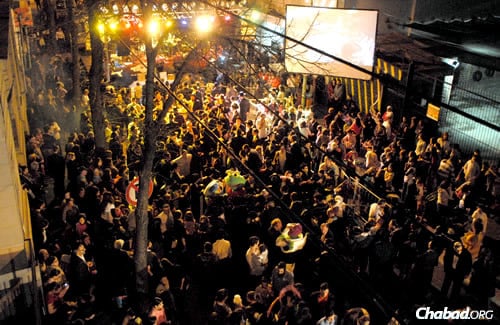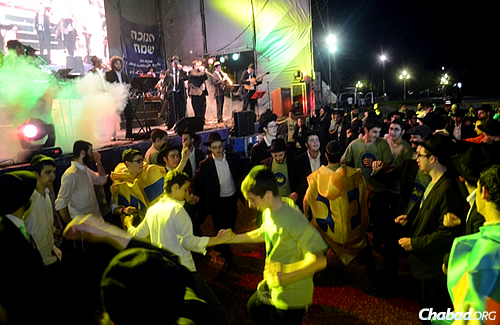The second of a three-part series on Chabad’s impact on Jewish life in Argentina, one of the largest Jewish communities in the world
BUENOS AIRES, Argentina—Chabad-Lubavitch of Argentina’s headquarters is located in the Once (UHN-say) neighborhood of Buenos Aires, a densely populated district that’s home to many of the city’s Jews and scores of Jewish institutions. Completed in the late 1990s, the colossal nine-story structure is protected by concrete security barriers and Israeli security guards—measures that were instituted across the Jewish community following the 1994 terrorist bombing of the AMIA (Argentine Israelite Mutual Association) building.
On any given day, the building buzzes with life. In addition to Chabad’s offices, the center houses a large synagogue, one of the most rigorous Chabad yeshivahs in the world and the Institute for Jewish Higher Studies (ISEJ), a social and educational network for Jewish college-aged students and young professionals. Rabbinical students with years of advanced Jewish studies under their belts mingle easily with university types, many of whom are only beginning to learn the foundations of their heritage.
Chabad’s presence in the country has grown immensely over time. Today, it caters to Israeli backpackers hiking the Andes from its center in Bariloche, the southernmost Chabad center in the world; has centers in distant cities, such as Bahia Blanca, Salta, Cordoba and Tucumán; and runs schools, synagogues and social-service organizations throughout Buenos Aires itself. One such center is located in the exclusive waterfront neighborhood of Puerto Madero, next door to the building where AMIA prosecutor Alberto Nisman, 51, was found dead in mid-January.
It wasn’t always like that. Back in 1978, when Rabbi Tzvi Grunblatt first returned to his home country with his wife, Shterna, Chabad was not nearly as conspicuous as it is today.
“When I came back,” says Grunblatt, smiling as he does, “I placed an ad in the Jewish paper telling myself ‘Shalom Aleichem’—welcoming myself to Argentina.”
Some Early Partners

Grunblatt may have placed the advertisement himself, but he wasn’t the only one who saw it. Not long afterwards, he got a phone call from a Mr. Abraham Gales, who informed the young emissary that he wanted to support Chabad with a $100 donation.
A tailor by trade, Gales’ factory manufactured the military uniforms of the army, which ruled the country under a brutal regime from 1976 until 1983. As for Gales himself, he used to tailor uniforms for the commanding generals of the junta. When Chabad planned to hold a large Lag BaOmer parade in Buenos Aires in 1980, the generals were wary of the true intentions of this activist Jewish group they knew so little about, so they decided to solicit the opinion of their trusted tailor, Gales.
“The generals asked him: ‘You know, there is a Jewish group, Lubavitch, and they want to make a parade in the streets. What do you say, are they political?’ He told them no, it’s not political; you don’t have to worry.”
Nevertheless, undercover government agents were mixed into the crowd that day to ensure that no political sentiments were slipped into the program of Jewish music and the 12 pesukim (Torah passages) joyously chanted by children.
“Mr. Gales taught me something very important,” recalls Grunblatt. “He told me in Yiddish: ‘Si doh mehrer gebbers, vi nemers;’ ‘There are more givers than there are takers.’ Money is not the problem; the money is there. [But] you have to do your part. That was his advice to me.”
Financial support, Grunblatt learned, did not necessarily come as a result of his own successful fundraising, and, in fact, emerged from some unexpected places. Soon after his arrival, Grunblatt met with a wealthy and influential Sephardic community leader named Beto Emsani. He began by explaining Chabad’s unique outreach approach and the mivtzoim campaigns instituted by the Lubavitcher Rebbe—Rabbi Menachem M. Schneerson, of righteous memory.

“He looked at me as I spoke and said, ‘Ah, you’re the guys who drive the mitzvah tanks in Manhattan? I like this; that’s what has to be done. You can’t sit inside a synagogue and hope someone comes in; you need to go out onto the street and find the Jews.’ Then he gave me $5,000. He told me that when I walked in, he saw a rabbi like any other and was going to give me $500 until he found out I was from the people who have the mitzvah tanks.”
The relationship between Grunblatt and the Emsani grew, and as it did, the gentleman introduced Grunblatt to a young Jewish man whom he thought Chabad could positively influence. His name was Tito Meta, who, along with his wife, Chipy, eventually became a central pillar of financial support for Chabad in Argentina and around the world.
“Later, Mr. Meta’s son, Andy, was approaching age 13 and told his father that he didn’t want to have a bar mitzvah,” Grunblatt recalls. “The boy was studying in a prestigious English-language school, and he was embarrassed in front of his non-Jewish classmates. Mr. Meta was very worried and didn’t know what to do.”
Meta shared his concern with the-then Israeli military attaché attached to the embassy in Buenos Aires, who suggested that Meta make a bar mitzvah for his son with Chabad in Israel. Meta reached out to Grunblatt, who, in turn, contacted the late Rabbi Yossie Raichik, legendary director of Chabad’s “Children of Chernobyl” project.
“I had a connection with the boy’s father already, but did not know the son,” says Grunblatt. “Yossie made the bar mitzvah for Andy in Israel, and it changed the boy’s life.”

The elder Meta has since passed away, but his wife, Chipy, and their son Andy and daughter Nati continue as principal benefactors of Chabad in Argentina, “Children of Chernobyl” and Colel Chabad.
“This connection we have with the family, it all goes back to the mitzvah tanks,” Grunblatt explains, as he names a number of key projects sponsored by the Meta family. “This is the difference; we go out into the streets. In the beginning, people here didn’t believe we were going to be able to go out and do the same kind of work as Chabad was doing in other places. When they saw we were doing it, they started seeing us differently.”
When People Simply ‘Disappeared’
The 1980s were not easy years to begin building a new Jewish institution in Argentina. For starters, the ruling military dictatorship made thousands of its political opponents “disappear,” in addition to anyone else caught up in the indiscriminate arrests associated with that time period. The government was known to dispose of its victims by placing them into weighted boxes and tossing them out of airplanes into the water below.
Some Jews who were active participants in leftist and socialist causes comprised a significant number of the regime’s victims. Additionally, despite its tight control of the country (or perhaps, because of it), Argentina also faced a significant financial crisis. The circumstances did not bode well for the future, but Chabad and the Jewish community at large persevered.
Planning larger-scale events was especially complicated when dealing with the military government, such as the time in 1982, when Grunblatt wanted to arrange a live telephone hookup of the Rebbe’s farbrengen (Chassidic gathering) in New York. The hookup was expensive and technically complex at the time; it looked like it would be difficult to pull off.

Grunblatt marched unannounced into the office of the military’s telecom point man—a fellow named Garcia, who as it so happened was married to a Jewish woman. Garcia went out of his way to help him, and the event went off without a hitch: Some 1,500 Argentine Jews filled the hall to partake live in a multi-hour farbrengen.
With a troubled economy on their hands, the Argentine government decided to bolster their sagging public support by launching a war against the United Kingdom over the Falkland Islands, in the hopes that a quick victory would rally national pride. Jews were among the soldiers, and the military sent two rabbis to serve as military chaplains: Grunblatt and his brother, Noson.
The United Kingdom defended the islands; Argentina surrendered after a two-and-a-half month war; and the junta fell one year later.
The Need to Build
Despite many early successes, the need to expand and construct a large new building weighed heavily on Grunblatt. In 1983, with little money in the bank but the strong desire to build, Grunblatt called the Rebbe’s office at 770 Eastern Parkway in the Crown Heights neighborhood of Brooklyn, N.Y., and asked the secretaries to request the Rebbe’s advice to the issue: ‘We are very cramped in our building. Should we build?’ ”
“I didn’t give any other details,” says Grunblatt. “The Rebbe’s reply was to build, also with no conditions, and the Rebbe sent $100.”
Soon, Grunblatt was signing a contract with a builder, writing checks making up the $50,000 needed as a deposit to pay for the building’s structure. The four checks were post-dated one week, despite the fact that Grunblatt didn’t have a penny in his account.
“I don’t remember how exactly we got the money,” he recalls, chuckling. “We somehow pulled it together. We did all sorts of crazy things.”
Three years into construction, Grunblatt ran out of money. With the Rebbe’s blessing, he flew to Australia, where Rabbi Yosef Gutnick, then a young Chassidic businessman, was making a name for himself as an active philanthropist. That summer, in 1987, Gutnick agreed to donate $200,000 to the effort, enough to get the project rolling again. Only a few months later, Gutnick’s fortune took a huge hit in the Black Friday stock-market crash.
“We had no prior relationship when he made that pledge,” says Grunblatt, “and despite the crash, he paid up the whole pledge.”

The pressure of finding necessary funds to complete construction of the 50,000-square-foot building continued to weigh heavily on Grunblatt. Recognizing the rabbi’s predicament, the project’s financier, a wealthy Argentine Jew named Alberto Sued, astounded him: “He told me that he planned on surprising me at the grand opening, but since he saw how I looked, he would give me the surprise early,” says Grunblatt. “He took all of the promissory notes that he owned and ripped them up on the spot.”
The building was completed in 1990, after which Sued and his wife flew to New York and presented its key to the Rebbe.
An Impactful Family and a Unity Torah
He is a soft-spoken and humble man, one who, during the Shabbat of this past Kinus Hashluchim, the International Conference of Chabad-Lubavitch Emissaries in New York, could be observed singing and dancing, listening or speaking together with hundreds of others at the central synagogue at 770.

But Eduardo Elsztain also happens to be one of the biggest entrepreneurs in South America, with vast real estate and agricultural holdings in Argentina and abroad. He is honorary president of Chabad of Argentina, and in that capacity has been a crucial partner for all Chabad activities in the country and even globally. Elsztain’s relationship with Chabad, however, began many years before the bright lights of fortune shined down upon him.
“I have known the Elsztain family since 1979,” says Grunblatt. “Eduardo’s parents participated in a class on Kabbalah given by Reb Avraham Yosef Polichenco, of blessed memory, who became one of the first Chabad Chassidim in Argentina as a result of his relationship with Reb Berel Baumgarten. They were very happy with the shiur [lesson] and asked where they could learn more, and he sent them here, to Aguero, where at the time we had an old house falling apart. The Elsztains came and started learning Tanya with me; we became closer; and that Pesach, they were at my home for the seder with their children, including Eduardo.”
Elsztain’s grandfather, who had emigrated from Russia in 1917, had at one time been a successful real estate investor, but by the late 1970s the family was struggling. Grunblatt recalls how Eduardo’s father, Mario, gave a $4,000 donation to cover the costs of printed materials needed for a large educational children’s event Chabad ran before Passover of 1980. “Eduardo later told me that for his father at the time, the $4,000 was an extremely difficult sum to give.”
In 1981, not long after the Rebbe announced a special campaign to unite Jewish children the world over by having them purchase a letter in a Torah scroll, Grunblatt came to the Elsztain family to sign up the younger ones (at its inception, the campaign was limited to children under bar and bat mitzvah age; it was later expanded to include all ages.) The Rebbe set the price of a letter at $1 or its equivalent in a foreign currency, and requested that children who were old enough pay for it from their own money, thus valuing their participation in worldwide Jewish unity.

The Rebbe further instructed that the Torah be written in the Tzemach Tzedek Synagogue in the Old City of Jerusalem, and that certificates be sent to all participating children, with their names written on it and detailing where in the Torah their letter was located. The Unity Torah Scroll project was massive in scope, and it had an unexpected impact on the business-minded Eduardo.
“I went to his father to write [Eduardo’s younger brother] Danny into the Torah, and Eduardo was shocked,” says Grunblatt. “He could not understand; where is the business here? How could so much effort and so much time be spent for just $1? Then he started to understand that there is another kind of value to things of Yiddishkeit, of Judaism, and he was very impressed. That had a big effect on him.”
These days, Elsztain is known internationally as a generous philanthropist, serving on boards of various Jewish institutions and footing the bill for, among other projects, a hostel for Israeli backpackers not far from his home in Buenos Aires. And his support of Chabad’s work remains unprecedented. Grunblatt says he was impressed with Elsztain all along, back to a 1984 trip that the spirited businessman made to the Soviet Union.
“I saw then that he was a special man. He went to Russia in 1984 and brokered the sale of two blocks of land in Belgrano [a neighborhood of Buenos Aires] for the Soviet embassy to be built upon; today, it is the Russian embassy. On that trip, he took shmurah matzah with him, and he saw it as his holy mission to deliver the matzah to people who needed it in the Soviet Union.
“Today, you would not be able to write about Chabad in Argentina—or even Jewish life in Argentina—without mentioning the name Eduardo Elsztain. It would be impossible.”
The first article in the series, “How Chabad Took Root in Argentina: The Early Years” can be read here.
The third article in the series, “Day School Gets High Marks for Turning the Jewish Educational Tide in Buenos Aires” can be read here.



Join the Discussion